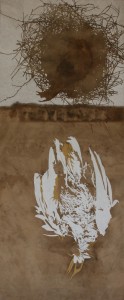Skip to content
 currawong
currawong
ARTIST STATEMENT
In order to investigate an involved as distinct from a detached process of representing animals in painting I have been collecting the bodies of deceased animals (typically road kill) and placing them on canvas to decompose over several months in order to produce a print or shroud-like impression of the body. My engagement with the species in our shared local environment, awareness of the nature of their death and contact with the individual body involve feelings of concern and care akin to a mortuary ritual. The process begins by placing the animal’s body into a canvas fixed to a sprung bed base. The decomposition site is located under a eucalyptus tree on a sheep farm in the Monaro region of NSW. The tree provides shelter for sheep, birds and other animals. A large male kangaroo that chose to die under the tree after being hit by a car helped determine my choice of site and was the first animal I had placed on canvas to decompose during the drought-stricken summer of 2008. The site becomes embedded into the work as the wind blows the canvas edge over the body, adding marks made with dust, leaves and sunlight or by collecting additional matter such as droppings and tree sap. The bed springs, its frame and the wire mesh holding the body firmly in place also make impressions on the canvas.
After removal of most debris and treatment of the canvas in vinegar to neutralise bacteria I then consider the aesthetic success of the decomposition print or shroud. I may then choose to dye the canvas using pigments extracted from eucalyptus leaves, which will also help further natural deodorisation. In some cases I employ bush-dyeing techniques taught to me by Kunwinjku speaking women textile artists in Gunbalanya, Western Arnhem Land, NT, during a recent extended research field trip. I have collected and been given mineral earth pigments in the form of natural ochres from sacred sites near Gunbalanya Western Arnhem Land, N.T., during a research field trip as well as my own country in the Jervis Bay region of NSW (traditional caretakers being the Yuin clans). The ochres featured in my works are mixed with natural wattle gum as a binder. Painters in Gunbalanya taught me to prepare ochres during the field trip. After stretching and sizing the canvas with rabbit skin glue, I may choose to work with the ochres in response to the shroud print, typically to add contextual features or representational forms. Further work into the shroud may also include careful sewing with silk or canvas thread. Both the application of ochre and sewing are time consuming thereby encouraging my intimate engagement with the traces of each individual animal body I have worked with. I view these embellishments as part of a mortuary ritual for the animal.
THE ARTIST
My name is Vanessa Barbay, I am a PhD painting student at the Australian National University supported by an ANU research scholarship. My studio practice based painting project investigates Australia’s animal populations and is supported by a dissertation exploring the traditional representation of animals by indigenous painters, particularly in site specific rock art.